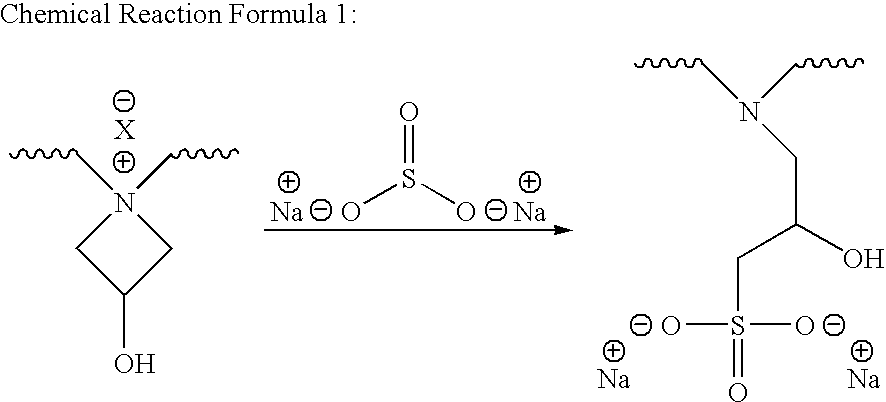Protein/Cationic Polymer Compositions Having Reduced Viscosity
a technology of cationic polymer and composition, applied in the field of protein/cationic polymer composition, can solve the problems of poor water resistance of soybean adhesive, difficult management of high viscosity systems, and strict use limitations of soybean adhesives
- Summary
- Abstract
- Description
- Claims
- Application Information
AI Technical Summary
Problems solved by technology
Method used
Image
Examples
examples 1-4
Effects of Various Viscosity Modifiers
[0043]PAE / soy adhesive formulations made were made with no sodium bisulfite “SBS”, with 0.5% sodium bisulfite, by weight based on total soy weight and 0.5% NaCl, both based on soy weight (Table 1). The sodium bisulfite was obtained from Aldrich Chemical Co., Milwaukee Wis., and had a purity of >99%, the sodium chloride was obtained from J. T. Baker, Phillipsburg, N.J., and was >99% purity. All formulations were prepared by combining distilled water (23 g), Kymene® 624 PAE polymer with a solids content of 20% (11.25 g, available from Hercules Incorporated., Wilmington Del.), and mixed with an overhead stirrer equipped with a propeller type mix blade for 2 minutes at 900 rpm. A quantity of Prolia® 100 / 90 soy flour (15.75 g, available from Cargill Inc., Minneapolis, Minn.) was then added to the stirred mixture, stirring was continued for 5 minutes at 900 rpm. At this point the additive (if any) was added and mixed for an additional 3 minutes, and f...
examples 5-10
Effects of Various Viscosity Modifiers
[0046]PAE / soy adhesive formulations made were made with no additive, with varying amounts of sodium bisulfite, varying amounts of cysteine, and one level of an Alcalase® enzyme (Table 2). The sodium bisulfite was obtained from Aldrich Chemical Co., Milwaukee Wis. and had a purity of >99%. The L-cysteine was obtained from Aldrich Chemical Co., Milwaukee Wis. and was >97% purity. The Alcalase® 2.4 L was from Novozymes, Franklinton, N.C. All formulations were prepared by combining distilled water (23 g), Kymene® 624 (11.25 g, available from Hercules Incorporated, Wilmington Del.), and mixed with an overhead stirrer equipped with a propeller type mix blade for 2 minutes at 900 rpm. At this point the additive (if any) was added. The additive percentages are based on soy weight, with the Alcalase® treated as 100% actives. A quantity of Prolia® 100 / 90 soy flour (15.75 g, Cargill Inc., Minneapolis, Minn.) was then added to the stirred mixture and stirri...
examples 11-16
Soy Flour Type
[0050]
TABLE 3Effect of Soy Flour Type on Adhesive Viscosity.ExampleSoy Flourggg%ViscositySpindle / NumbertypeSoyCA 1000WaterSBSpH(cP)rpm11Prolia31.522.5640.00%5.66178,0007 / 10100 / 9012Prolia31.522.5640.50%5.5822,0007 / 20100 / 9013Prolia31.522.5640.00%5.78250,0007 / 10200 / 2014Prolia31.522.5640.50%5.7277,0007 / 20200 / 2015Kaysoy31.522.5640.00%5.7278,0007 / 1016Kaysoy31.522.5640.50%5.6584,0007 / 20
[0051]These samples were all prepared using CA1000 PAE polymer with a solids content of 20%, available from Hercules Incorporated, Wilmington Del., and sodium bisulfite obtained from Aldrich Chemical Company, Milwaukee Wis., >99% purity. The soy flours used in this study were Prolia® 100 / 90 defatted soy flour and Prolia® 200 / 20 defatted soy flour, both available from Cargill, Inc., Minneapolis Minn. and Kaysoy® toasted soy flour, available from Archer-Daniels Midland (ADM), Decatur Ill. The formulations were made with a recipe of 64% water, 22.5% CA1000 PAE polymer having a solids content of 20...
PUM
| Property | Measurement | Unit |
|---|---|---|
| Fraction | aaaaa | aaaaa |
| Fraction | aaaaa | aaaaa |
| Fraction | aaaaa | aaaaa |
Abstract
Description
Claims
Application Information
 Login to View More
Login to View More - R&D
- Intellectual Property
- Life Sciences
- Materials
- Tech Scout
- Unparalleled Data Quality
- Higher Quality Content
- 60% Fewer Hallucinations
Browse by: Latest US Patents, China's latest patents, Technical Efficacy Thesaurus, Application Domain, Technology Topic, Popular Technical Reports.
© 2025 PatSnap. All rights reserved.Legal|Privacy policy|Modern Slavery Act Transparency Statement|Sitemap|About US| Contact US: help@patsnap.com

